Search results for "2011/04/matti-suurpaa-parnasso-1951–2011-parnasso-1951–2011"
Hannele Huovi & Kristiina Louhi: Jättityttö ja Pirhonen [The giant girl and Mr Pirhonen]
17 January 2012 | Mini reviews, Reviews
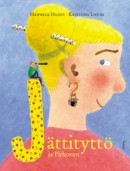 Jättityttö ja Pirhonen
Jättityttö ja Pirhonen
[The giant girl and Mr Pirhonen]
Kuvitus [Ill. by]: Kristiina Louhi
Helsinki: Tammi, 2011. 31 p.
ISBN 978-951-31-5852-1
€ 19.95, hardback
Hannele Huovi and Kristiina Louhi, two eminent professionals in the field of children’s literature, have been collaborating for a long time. Their mutual trust is reflected in the way they grant each other artistic freedom, at times submitting to the text, at others to the illustrations. The depiction of the love story between a giant girl and a tiny man was an exceptional challenge for the illustrator; Tyyne’s tears nearly drown her tiny friend, and to see him properly, she needs a magnifying glass! Louhi has again kept her style economical, and she boldly paints large expanses of colour and forms. Alongside the unequal but happy love story, this picture book deals with tolerance. Tyyne’s enormous size effectively manifests her feeling that she is an outsider. The book also advocates a relaxed attitude to life and the avoidance of unnecessary strain. The example of the giant girl helps the reader to develop a sense of proportion and to realise the value of the everyday.
Translated by Fleur Jeremiah and Emily Jeremiah
Tuomas Heikkilä & Liisa Suvikumpu: Suomen Turku julistaa joulurauhan. Åbo kungör julfred [Finland’s Turku announces the Christmas peace]
9 December 2011 | Mini reviews, Reviews
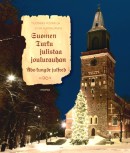 Suomen Turku julistaa joulurauhan. Åbo kungör julfred
Suomen Turku julistaa joulurauhan. Åbo kungör julfred
[Finland’s Turku announces the Christmas peace]
Swedish translation: Malena Torvalds-Westerlund
Helsinki: Kirjapaja, 2011. 71 p., ill.
ISBN 978-952-247-229-8
€ 24, hardback
This bilingual book offers a broad interpretation of a unique Christmas tradition upheld by the Finns: at 12 on Christmas Eve a large proportion of the population falls silent to listen to the declaration of the Christmas peace from Turku cathedral. After its bells have rung noon, the deputy mayor ceremonially opens a manuscript prepared according to mediaeval tradition and reads the announcement in both Finnish and Swedish. After the announcement, the land settles down to celebrate Christmas following traditions dating from the 13th century. The Christmas peace has been announced in Turku almost without interruption since the Middle Ages. The last time it went unread was in 1939, during the Winter War. The Finnish Broadcasting Company broadcasts the occasion to all the member countries of the European Broadcasting Union EBU. The Christmas peace is also sent out into the world by Swedish radio, reaching a total of some 140 countries.
Translated by Hildi Hawkins
Vesa Puuronen: Rasistinen Suomi [Racist Finland]
6 July 2011 | Mini reviews, Reviews
 Rasistinen Suomi
Rasistinen Suomi
[Racist Finland]
Helsinki: Gaudeamus, 2011. 286 p., ill.
ISBN 978-952-495-196-8
€ 36, paperback
Multiculturalism, immigration and racism have become more frequent subjects of discussion in Finland, particularly as a result of the 2008 local elections and the subsequent speeches and writings by people critical of immigration. This book aims to move the discussion forward by describing and defining racism, presenting developments in research into racism, racism perpetrated by Finns against Sámi and Russians, and the history of Finnish enmity towards Russians from the early 20th century to the present day. The author considers the use of shaming and subjugation as tools of exterminating Sámi culture, as well as linguistic discrimination and denial of land ownership rights against the Sámi. The book also examines the development of hate crimes since the 1990s, racism in Finnish politics and the politics of multiculturalism as practised in Finland, which studies have shown treat different minority groups in different ways. Vesa Puuronen is a sociologist and a researcher into racism who works at the University of Eastern Finland.
Translated by Ruth Urbom
Taken by surprise
In her fifth collection of poems, Pauliina Haasjoki explores night flights, water, islands, sandy beaches where time is found stratified in stones and fossils. Interview by Teemu Manninen
Poems from Aallonmurtaja (‘Breakwater’, Otava, 2011)
Night flight
Man cannot hide in the night, his desire will betray him.
Man turns toward the lights, light sparkles as though it were close at hand
even if it is far away.
Lights, which offer themselves like jewels to the one who sits in the plane above them, are already
in their viewers’
eyes even if they have only just begun to stream from their source. A city-jewel swaying
in the black night air.
A solitary light on the surface of an island. Seen close up it is a soft-lit lamp
which casts light only on the table and the faces around it,
but from above, at a distance of kilometres, it is an immediate spot, a straight line that
aims at the viewer
and pierces her. A fierce light-beam.
Finlandia Prize for Non-Fiction 2012
5 December 2012 | In the news
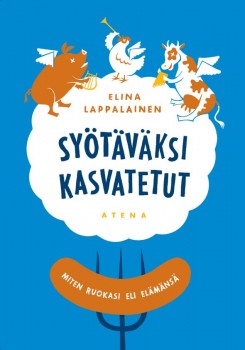 ‘It is one of the rules of quality journalism that writers aim for even-handed and impartial reporting, but at the same time challenge their respondents to account for their actions. Writers should also have the capacity for in-depth reporting and analysis,’ said Janne Virkkunen, former Editor-in-Chief of Helsingin Sanomat newspaper on 8 November, as he announced the winner of this year’s Finlandia Prize for Non-Fiction, worth €30,000.
‘It is one of the rules of quality journalism that writers aim for even-handed and impartial reporting, but at the same time challenge their respondents to account for their actions. Writers should also have the capacity for in-depth reporting and analysis,’ said Janne Virkkunen, former Editor-in-Chief of Helsingin Sanomat newspaper on 8 November, as he announced the winner of this year’s Finlandia Prize for Non-Fiction, worth €30,000.
The winner, Syötäväksi kasvatetut. Miten ruokasi eli elämänsä (‘Grown to be eaten. How your food lived its life’, Atena) by the young journalist Elina Lappalainen, is her first book.
‘The book could have fallen prey to the sensationalism of which we all probably have experience in the media, at least. This writer was able to avoid the temptation,’ Janne Virkkunen said.
The other works on the shortlist of six were as follows: Arabikevät (‘The Arab spring’, Avain), a study of spring 2011 in the Arab world by Lilly Korpiola and Hanna Nikkanen, Norsusta nautilukseen. Löytöretkiä eläinkuvituksen historiaan (‘From the elephant to the nautilus. Explorations into the illustration of animals’, John Nurminen Foundation) by Anto Leikola, Kevyt kosketus venäjän kieleen (‘A light touch to the Russian language’, Gaudeamus) by professor of Russian Arto Mustajoki, Karhun kainalossa. Suomen kylmä sota 1947–1990 (‘Under the arm of the Bear. Finland’s Cold War 1947–1990’, Otava) by Jukka Tarkka and Markkinat ja demokratia. Loppu enemmistön tyrannialle (‘Market and democracy. The end of the tyranny of the majority’, Otava) by banker Björn Wahlroos.
Tuuve Aro: Korson purppuraruusu [The purple rose of Korso]
16 January 2012 | Mini reviews, Reviews
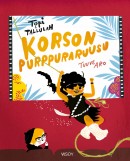 Korson purppuraruusu
Korson purppuraruusu
[The purple rose of Korso]
Kuvitus [Ill. by]: Sanna Mander
Helsinki: WSOY, 2011. 109 p.
ISBN 978-951-0-38052-9
€ 25.70, hardback
Sometimes a book’s appearance is enough to win the reader over. The first children’s novel by writer and film critic Tuuve Aro (born 1973) encourages the belief that things will work out for the best. The book’s positive undertones are also reflected in Mander’s fresh illustrations, which exude retro-nostalgia for the 1950s and 1960s in shades of orange, black, and brown. Tallulah, a jungle princess, turns up unexpectedly to sort out the complicated affairs of Topi, a schoolboy who is being bullied. Tallulah comes into the suburb of Korso from the silver screen, out of Woody Allen’s film The Purple Rose of Cairo. The jungle princess helps Topi to see the bleak suburb as an exotic habitat where adventures are waiting just round the corner. The adult reader gets to enjoy a few carefully chosen references to major cinematic landmarks. Aro eschews problem-centred realism and angst, even though the children’s problems are an indirect result of decisions taken by adults. The Tallulah figure incorporates a hefty dose of anarchy, familiar from Astrid Lindgren’s Pippi Longstocking.
Translated by Fleur Jeremiah and Emily Jeremiah
Tiia Aarnipuu: Jonkun on uskallettava katsoa. Animalian puoli vuosisataa [Someone’s got to dare to look. Half a century of Animalia]
28 July 2011 | Mini reviews, Reviews
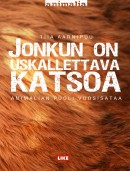 Jonkun on uskallettava katsoa. Animalian puoli vuosisataa
Jonkun on uskallettava katsoa. Animalian puoli vuosisataa
[Someone’s got to dare to look. Half a century of Animalia]
Helsinki: Like Kustannus, 2011. 209 p., ill.
ISBN 978-952-01-0582-2
€ 33, paperback
This book has been published to mark the 50th anniversary of Animalia, the Federation for the Protection of Animals. The public image of the organisation has varied between one of a conservative club of ladies and gentlemen and that of a radical terrorist group. Animalia was founded in 1961, inspired by Johan Börtz, a Swede who gave lectures on the plight of animals used in experiments. Animalia began making visits to inspect animal testing facilities, which were completely unregulated in the early 1960s. Gradually the animal rights movement became more radicalised, somewhat later than in places such as Britain. Animal rights became a subject of wider debate in Finland in the 1980s. In the 1990s, the organisation was falsely linked with attacks made on fur farms by direct-action youth groups. Animalia’s stance has been to renounce vandalism and violence. In February 2010 Animalia launched its largest-ever information campaign, aimed at ridding Finland of fur farms by 2025.
Translated by Ruth Urbom
Leena Krohn: Auringon lapsia [Children of the sun]
16 January 2012 | Mini reviews, Reviews
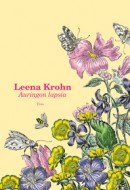 Auringon lapsia
Auringon lapsia
[Children of the sun]
Kuvitus [Ill. by]: Inari Krohn
Helsinki: Teos, 2011. 32 p.
ISBN 978-951-851-311-0
€ 29.40, hardback
It is great news that Leena Krohn has not abandoned the young readership she first addressed through her first book Vihreä vallankumous (‘The green revolution’, 1970), an ecocritical title that also touched on active citizenship. This novel, too, is about the encounter between man and nature. Ten-year-old Orvokki (Violet) is a delivery girl for a florist; like her, the reader is incited to marvel with naive curiosity at life’s various wonders. Krohn is supremely good at writing literature that knows no age limits. Nothing here will go over a child’s head; the essence of the book is accessible to all. In this nicely old-fashioned children’s novel the measured language and expression are pleasing both to the eye and the ear. The hand-coloured graphic prints by the artist (and writer’s sister) Inari Krohn are a homage to Maria Sibylla Merian (1647–1717), the German natural scientist and illustrator who produced life-like paintings of insects and plants.
Translated by Fleur Jeremiah and Emily Jeremiah
We are the champions
25 March 2011 | Prose
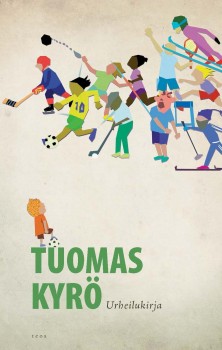 Heroes are still in demand, in sports at least. In his new book author Tuomas Kyrö examines the glorious past and the slightly less glorious present of Finnish sports – as well as the meaning of sports in the contemporary world where it is ‘indispensable for the preservation of nation states’. And he poses a knotty question: what is the difference, in the end, between sports and arts? Are they merely two forms of entertainment?
Heroes are still in demand, in sports at least. In his new book author Tuomas Kyrö examines the glorious past and the slightly less glorious present of Finnish sports – as well as the meaning of sports in the contemporary world where it is ‘indispensable for the preservation of nation states’. And he poses a knotty question: what is the difference, in the end, between sports and arts? Are they merely two forms of entertainment?
Extracts from Urheilukirja (‘The book about sports’, WSOY, 2011; see also Mielensäpahoittaja [‘Taking offence’])
The whole idea of Finland has been sold to us based on Hannes Kolehmainen ‘running Finland onto the world map’. [c. 1912–1922; four Olympic gold medals]. Our existence has been defined by how we are known abroad. Sport, [the Nobel Prize -winning author] F. E. Sillanpää, forestry, [Ms Universe] Armi Kuusela, [another runner] Lasse Viren, Nokia, [rock bands] HIM and Lordi, Martti Ahtisaari.
The purpose of sport at the grass-roots level has been to tend to the health of the nation and at a higher level to take our boys out into the world to beat all the other countries’ boys. We may not know how to talk, but our running endurance is all the better for it. However, the most important message was directed inwards, at our self image: we are the best even though we’re poor; we can endure more than the rest. Finnish success during the interwar period projected an image of a healthy, tenacious and competitive nation; political division meant division into good and bad, the right-minded and traitors to the fatherland. More…
Aamu Nyström: I.K. Inha – Valokuvaaja, kirjailija, kulttuurin löytöretkeilijä [I.K. Inha – Photographer, writer, cultural explorer]
3 August 2011 | Mini reviews, Reviews
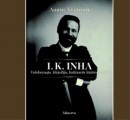 I.K. Inha – Valokuvaaja, kirjailija, kulttuurin löytöretkeilijä
I.K. Inha – Valokuvaaja, kirjailija, kulttuurin löytöretkeilijä
[I.K. Inha – Photographer, writer, cultural explorer]
Jyväskylä: Minerva, 2011. 271 p., ill.
ISBN 978-952-492-441-2
€ 31, hardback
I.K. Inha (1865–1930) was a photographer, a writer, a translator and a journalist. He is known particularly for his photographic journeys in Finland and Russian Karelia. Both the texts and the photographs in Inha’s landscape and nature works are of a high aesthetic standard. This book focuses on Inha’s lesser-known works and the various phases of his life. Inha’s travel diary documents the cycle journey he made as a student in 1886 to Germany and Switzerland. In 1897 Inha was appointed Finland’s first-ever foreign correspondent; from Athens he reported on events such as the Greco-Turkish War. In 1899 and 1901 Inha was posted to England, where he observed Queen Victoria’s funeral and the coronation of King Edward VII. Aamu Nyström, the niece of Inha’s brother, has had access to letters, photographs and written and oral recollections of family members.
Translated by Ruth Urbom
Translation prize to Angela Plöger
23 October 2014 | In the news
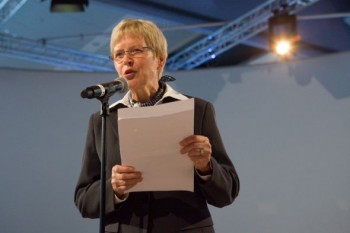
Angela Plöger, Frankfurt Book Fair, 8 October. Photo: Katja Maria Nyman
The 40th Finnish State Prize for the Translation of Finnish Literature of 2014 – worth €15,000 – was awarded to the German translator Angela Plöger at the Frankfurt Book Fair on 8 October.
Dr Angela Plöger (born 1942) studied Finnish and Fennistics in Berlin; she first came to Finland in the 1960s after having become interested in the Finnish language as a result of learning Hungarian.
‘I had been to the restaurant at the Helsinki Railway Station where Bertolt Brecht was thinking how the noblest part of a man is his passport, and how Finns are a people who keeps silent in two languages.’
Plöger then defected to West Germany, starting her career anew. She has also translated texts from Hungarian and Russian. In her speech in the Finnish Pavilion of the Book Fair Plöger said that in her opinion translating literature is the most fascinating profession in the world.
Her first translation of a Finnish novel was Tamara, by Eeva Kilpi, published in 1974. Among the most recent of the 40 novels Plöger has translated during the past five decades from Finnish are the novels Kätilö (‘Midwife’, 2011) by Katja Kettu and Kun kyyhkyset katosivat (‘When the doves disappeared’, 2012) by Sofi Oksanen. Among the other works Plöger has translated are novels by Leena Lander, Eeva-Kaarina Aronen, Anja Snellman, Kaari Utrio, Johanna Sinisalo, Risto Isomäki and Antti Tuuri, as well as a number of drama texts by Laura Ruohonen, Juha Jokela, Aki Kaurismäki, Pirkko Saisio and Sofi Oksanen.
The Minister for Culture and Housing, Pia Viitanen, thanked Plöger for her extensive and multi-faceted work in the field of language and literature and in promoting Finnish literary culture in Germany.
The prize, worth € 15,000, has been awarded by the Ministry of Education and Culture since 1975 on the basis of a recommendation by FILI – Finnish Literature Exchange.
Vilja-Tuulia Huotarinen: Valoa valoa valoa [Light light light]
13 January 2012 | Mini reviews, Reviews
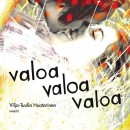 Valoa valoa valoa
Valoa valoa valoa
[Light light light]
Hämeenlinna: Karisto, 2011. 125 p.
ISBN 978-951-23-5433-7
€ 19.95, paperback
Vilja-Tuulia Huotarinen’s novel for young adults demonstrates the author’s familiarity with classic books for girls, her skill in plotting, and, above all, her respect for youth on its own, unique terms. The novel is set in the summer and autumn of 1986. A nuclear explosion occurs at Chernobyl, Ukraine, in spring, and the fall-out worries 14-year old Mariia, who lives on the outskirts of Turku. She befriends Mimi, who has a dark secret in the attic. The friendship between the two girls soon deepens into love, and is described by Huotarinen (born 1977) beautifully and openly. Huotarinen’s language is colloquial, but nevertheless highly lyrical. Valoa valoa valoa promises a revival in the Finnish novel for young adults; it does not wallow in youthful angst or ‘issues’, although the story touches on these things, too. Self-conscious narration, metafiction, adds another intriguing twist to the story.
Translated by Fleur Jeremiah and Emily Jeremiah
Consume culture, live longer!
16 May 2013 | This 'n' that
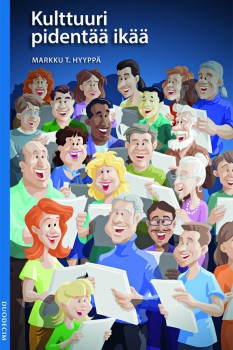 A culture freak (and you don’t have to be a vulture) will live longer than a couch potato.
A culture freak (and you don’t have to be a vulture) will live longer than a couch potato.
This sounds pretty obvious, doesn’t it? Watching TV is a passive pursuit, attending choir rehearsals or line dancing class isn’t – and human beings are designed to be active.
But it is also a scientific fact. Neurologist and writer MD Markku T. Hyyppä has been researching the effects of cultural pursuits on health for decades. In his new book Kulttuuri pidentää ikää (‘Culture prolongs your life’) he sets out to prove the power of culture using scientific evidence from many countries.
Cultural capital is a concept that defines the ‘usefulness of culture’. Hyyppä disagrees with the famous sociologist Pierre Bourdieu who defines cultural capital as a means for the upper classes to increase their personal status and power. According to Hyyppä, cultural capital is immaterial, originates from cultural pursuits and the consumption of culture, and brings benefits to all who take part.
Learning the basics of culture in one’s education is vital: Finland has done well in the international PISA exams, but it’s not just because the children are bright. Learning how to educate is important: unlike in many other countries, the arts play a significant role in teacher training in Finland. And arts subjects are important in education: art has a positive effect on emotions and cognition, on emotional life as well as reason. Study arts subjects, and it will be easier to learn maths!
It’s a fact is that those who are socially active in clubs, associations and cultural pursuits in general, live longer than those who are not. Economic status is not a decisive factor here. The efficacy of cultural pursuits and cultural capital on prolonging an individual’s life appears to be based on networking. i.e. social capital. Social capital increases the chances of staying alive – almost as much as non-smoking and much more than the estimated extra time of exercise or losing weight. An individual’s cultural pursuits allow him at least a couple of years more in old age.
Hyyppä also examines and comments on the cultural policies of Finnish political parties. After the Perussuomalaiset – True Finns – party presented its manifesto in 2011, stating that contemporary art should not receive any public funding, as only art that ‘strengthens the national identity’ should be funded, other political parties began hastily to revise and update their dusty arts programmes. As it has been proved in international and Finnish medical research that culture definitely has a positive impact on developing society as a whole, political parties cannot afford to ignore dealing with the subject.
In conclusion, Hyyppä states that Finland would certainly benefit from the cultural added value that manifests itself in well-being, health and a longer life spans. When people live longer healthy, the national economy gains massively.
It’s not just opera, ballet and favouring the paintings of the Düsseldorf school that bring you cultural capital and prolong your existence; rock concerts or pottery classes are fine, too. But, notes Hyyppä, being active in politics in your free time, going to church and participating in spectator sports don’t seem to have a similar positive effect, so might it be better not to concentrate on those alone?
Markku T. Hyyppä
Kulttuuri pidentää ikää
(‘Culture prolongs your life’)
Helsinki: Duodecim, 2013. 132 p.
ISBN 978-951-656-479-4
Remains healthy
13 April 2011 | Non-fiction
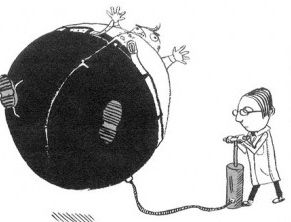
Case note: patient has coronary artery disease for which he was given a balloon. Illustration: Elina Warsta
In these samples from a collection of patient reports, Molemmista päistä tähystetty: päättömiä potilaskertomuksia (‘Examined at both ends: brainless patient reports’, Otava, 2011), human disorders appear bizarre, puzzling or just plain funny in case notes as dictation or transcription occasionally proves erratic
The patient was given instructions for his bowels.
Recommend milder aerobics, ie swimming on an exercise bicycle.
Patient is a healthy 70-year-old girl.
And a mental health evaluation is recommended for the designer of this form. More…
Päivi Jantunen: Kaj & Franck. Esineitä ja lähikuvia / Designs & Impressions
6 July 2011 | Mini reviews, Reviews
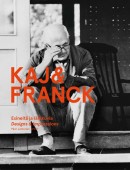 Kaj & Franck. Esineitä ja lähikuvia. / Designs & Impressions
Kaj & Franck. Esineitä ja lähikuvia. / Designs & Impressions
English translations: Peter Herring and Esa Lehtinen
Helsinki: WSOY, 2011. 166 p., ill.
ISBN 978-951-0-36898-5
€ 42, hardback
This dual-language book showcases the work of one of Finland’s most widely known glass and ceramic designers in his centenary year. The unaffected designs and clean geometric shapes of the tableware designed by Kaj Franck (1911–1989) are well suited to a wide range of cultures. Franck’s guiding principle was to create anonymous, self-evident objects for everyday use. In the 1940s and 1950s, Franck updated tableware to match post-war changes in society; he wanted to get away from the sets of crockery that filled up smaller kitchen cupboards. His designs that emphasised environmental principles and equality were ahead of their time with their ideology of sustainable development. This book portrays Franck’s life and career, which centred on the oldest glassworks in Finland in the community of Nuutajärvi, where he worked from the early 1950s until his death. Interviews with local residents and Franck’s colleagues create a portrait of him as a colourful personality. Ample illustrations provide a cross-section of Franck’s design output. In addition to his mass-produced items, there are photos of Franck’s one-off artistic creations.
Translated by Ruth Urbom
